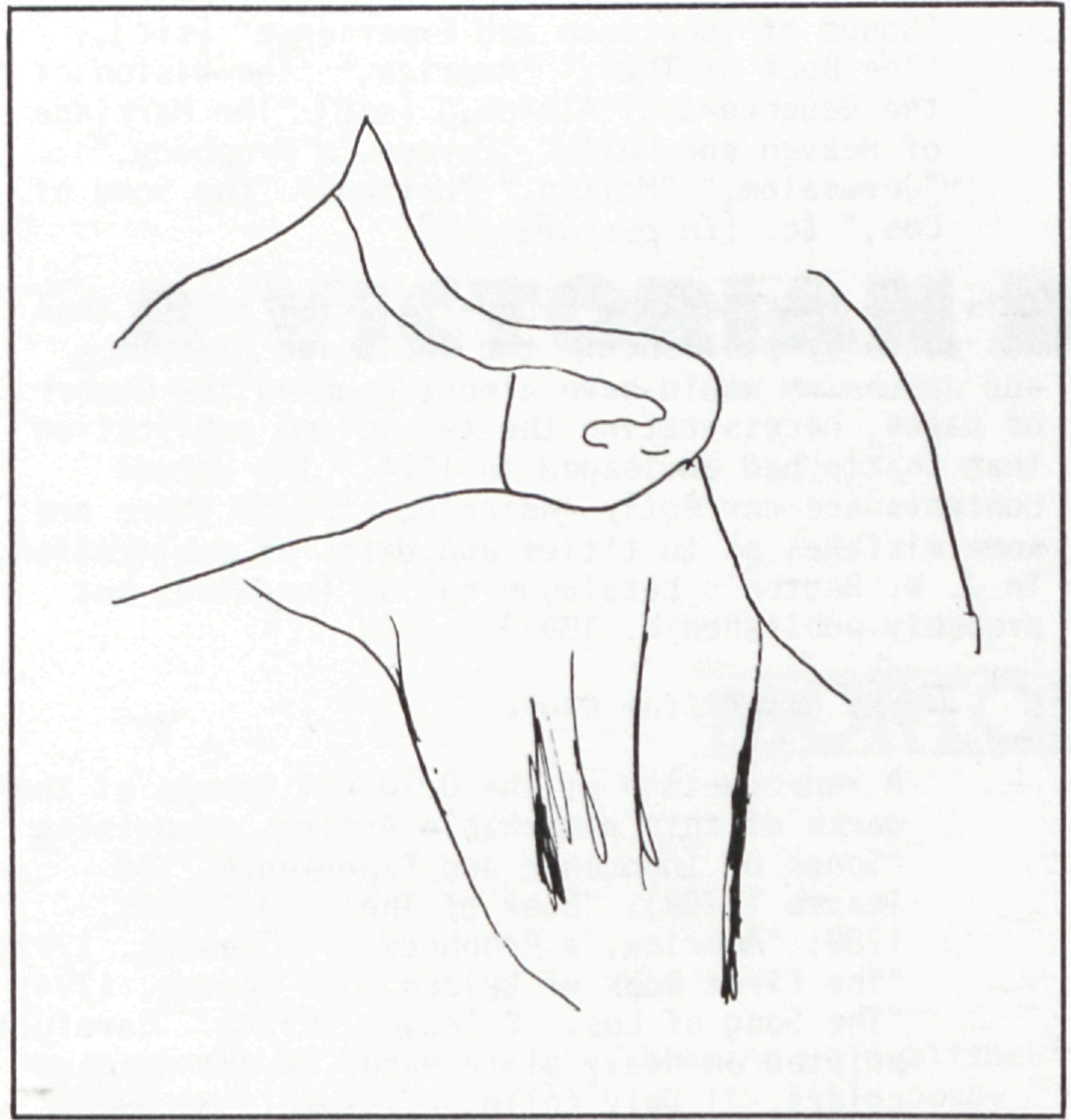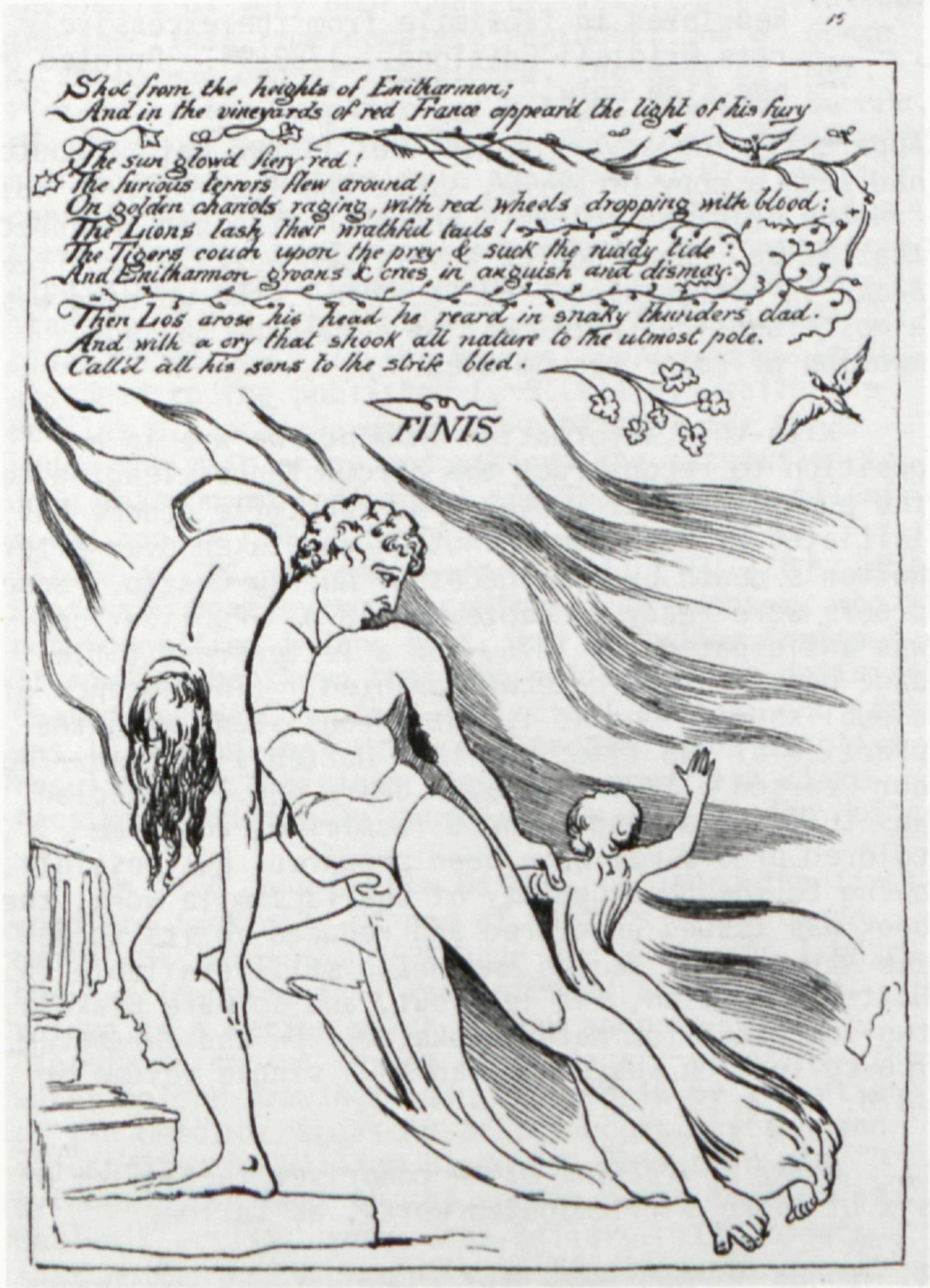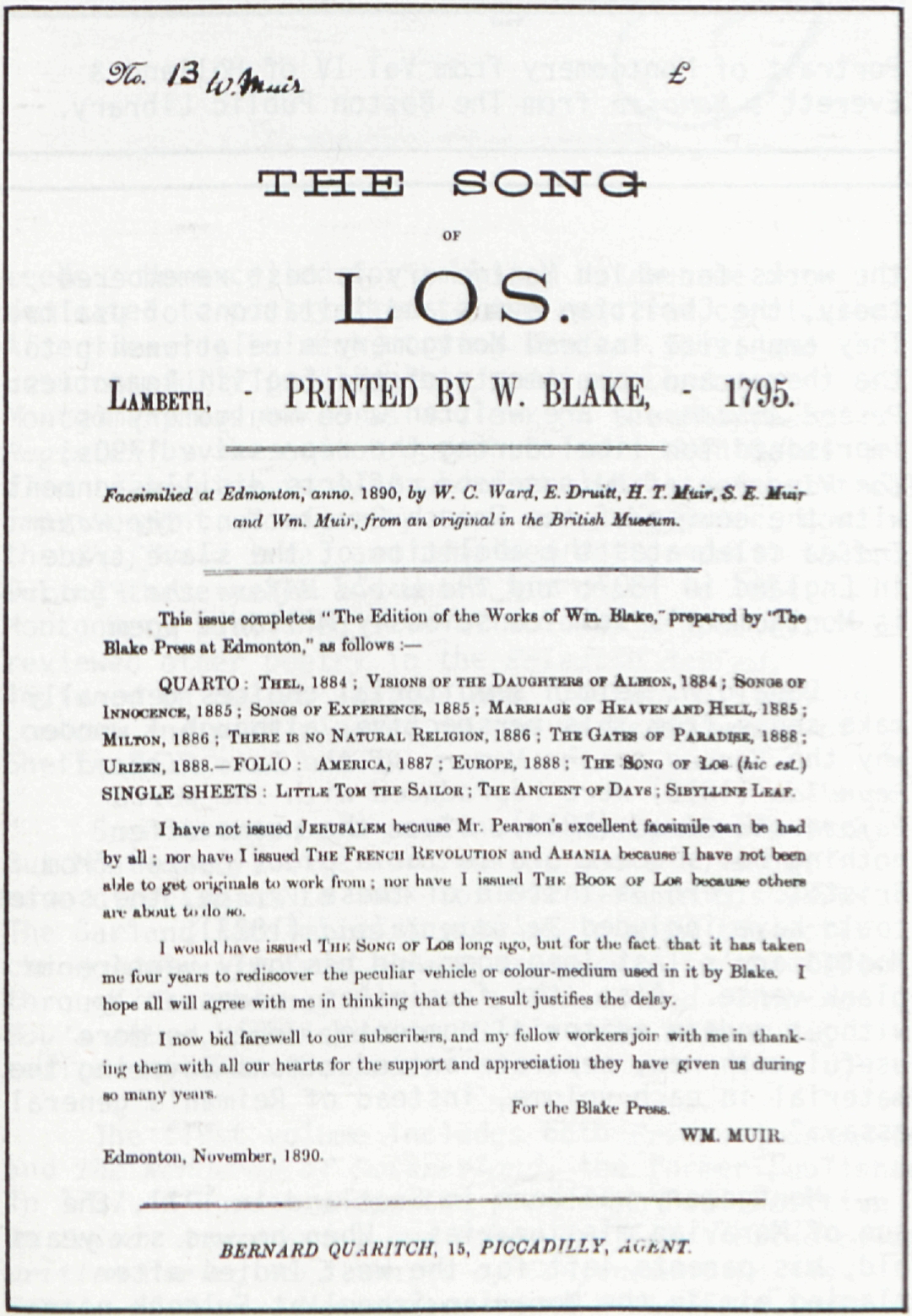article
begin page 24 | ↑ back to topA VICTORIAN BLAKE FACSIMILE
Works of William Blake, bearing no publisher’s imprint and dated 1876 on its title page, has posed a minor conundrum in Blake scholarship. The title page announces it as “Reproduced in Facsimile From the Original Editions. One hundred copies printed For private circulation.” It is a facsimile of very poor quality, yet it made available for the first time complete reproductions of Songs of Innocence and of Experience, The Book of Thel, Visions of the Daughters of Albion, America, Europe, The Book of Urizen, and The Song of Los. These were not to appear in facsimile again until William Muir’s considerably better productions of 1884-90.1↤ 1 The Edition of the Works of William Blake (Edmonton: The Blake Press). Thus Works has some historical importance as a pioneering albeit seriously flawed project, but the circumstances of its publication have never been made clear up to now. In the Keynes Bibliography it is assigned to the publisher F. S. Ellis,2↤ 2 Geoffrey Keynes, A Bibliography of William Blake (New York: Grolier Club, 1921), pp. 293-94. while the Bentley Blake Books gives no publisher for Works under the main entry and assigns the facsimiles to John Pearson in individual entries for each illuminated book.3↤ 3 G. E. Bentley, Jr., Blake Books (Oxford: The Clarendon Press, 1977), pp. 501, 102, 159, 126, 181, 426, 473. Professor Bentley now agrees that Works should be attributed to Chatto and Windus and the 1877 Jerusalem to John Pearson, and has kindly given me the benefit of his criticism in the preparation of this note. I am also indebted to Professor Robert N. Essick for invaluable information. In “A Supplement to Blake Books” (Blake/An Illustrated Quarterly, 11 [1977-78], 148), Professor Bentley suggests that “The sponsor, who is not identified in the book, may be Andrew Chatto.” It now can be shown that the publisher was definitely Chatto and Windus, that the actual date of publication was 1878, and that Works was probably the abortive result of an ambitious plan for a complete Blake facsimile originally conceived by John Camden Hotten.
In 1868 John Camden Hotten published the first complete facsimile of one of Blake’s illuminated books, The Marriage of Heaven and Hell. As I have shown elsewhere, this was intended as the first volume in a series which Hotten announced as “facsimile copies (exact as to paper, printing—the water-colour drawings being filled in by an artist) of the ORIGINAL EDITIONS of the books written and illustrated by William Blake.”4↤ 4 See my article “John Camden Hotten, A. C. Swinburne, and the Blake Facsimiles of 1868,” Bulletin of the New York Public Library, 79 (1976), 259-96. The quotation is from an excerpt from a sale catalogue in a copy of the Hotten Marriage facsimile in the collection of Robert N. Essick. This plan was evidently set back by the sudden death in 1868 of Hotten’s artist, Henry John Bellars. It appears that Hotten had difficulty in finding another facsimilist of Bellars’ skill, for on 8 September 1870 Hotten wrote to the printers Banks & Co.: “I may ask if you have an artist who can successfully reduce Cruikshank’s etchings & draw on stone (or engrave), the printing to be done in colours like the plates to Tom and Jerry.”5↤ 5 Quotations from the letters of John Camden Hotten and of Andrew Chatto are from the copies in the Letter Books of Chatto and Windus, to whom I am grateful for permission to use them. When Hotten died in 1873 at the age of forty, no further Blake facsimiles had been issued.
After Hotten’s death, a chestful of drawings after Blake, some of which may have been studies by Bellars for the projected facsimile, was found in Hotten’s cellar. These drawings were bought by the New York dealer J. W. Bouton and offered for sale as genuine Blakes, laying the ground for the story of the “John Camden Hotten forgeries.” Meanwhile Hotten’s business was acquired by his former publishing associate Andrew Chatto, who was joined in partnership by W. E. Windus. The plan for an extensive Blake facsimile was not abandoned, and in the following year considerable progress was made on it. On 17 September 1874 Chatto wrote to William Michael Rossetti, who had assisted Hotten with his Blake projects:
Dear SirChatto must have found, however, that the time required was longer than had been anticipated, for begin page 25 | ↑ back to top
I send herewith sample proofs of facsimiles of six more of Wm Blake’s works. When carefully coloured by hand they will look wonderfully like the originals
Printed on paper the present size the whole of Blakes works might be contained in 2 volumes, but I think it will be desirable to strike off a few copies to be sold separately on paper the approximate size of the originals.
Yours very faithfully,
Andrew Chatto
In their list for 1877, Chatto and Windus advertised the facsimile as follows: ↤ 7 From an unpaginated list appended to Choice Humourous Works by Mark Twain (London: Chatto and Windus, 1877).
Blake’s WorksThis is a considerably broader list of titles than was actually published: the inclusion of Milton and Jerusalem would have almost doubled the number of pages, necessitating the two volume publication that Chatto had envisaged in 1874. The actual contents are correctly indicated, though there are some mistakes as to titles and dates of publication, in J. W. Bouton’s catalogue no. 56 (undated, but probably published c. 1881): ↤ 8 The readings should of course be “Songs of Innocence and of Experience” and “Visions of the Daughters of Albion.” The latter was published in 1793, not 1789; The Book of Thel bears the publication date 1789 and not 1794; and The Song of Los was published in 1795 not 1794. For some reason The Book of Los, the sole known copy of which had been sold to the British Museum in 1866, was not part of the plan. Neither was The Book of Ahania, the sole known copy of which was then in the collection of Lord Houghton. The first facsimiles of these two books were published by E. J. Ellis and W. B. Yeats in volume III of The Works of William Blake, Poetic, Symbolic and Critical (London: B. Quaritch, 1893).
A series of Reproductions in Facsimile of the Works of William Blake, including the “Songs of Innocence and Experience” [sic], “The Book of Thel,” “America,” “The Vision of the Daughters of Albion,” [sic] “The Marriage of Heaven and Hell,” “Europe, a Prophecy,” “Jerusalem,” “Milton,” “Urizen,” “the Song of Los,” &c. [in preparation]7
Works of William BlakeApparently the advertisement was issued before Bouton had seen a copy of Works, since the facsimile is not “in the original colors,” though Chatto had intended that it be. When Bouton advertised Works of William Blake in his catalogue 63 (c. 1885), the wording was almost identical with that of catalogue 56, but mention of color was omitted.
A reproduction of the Original issues of the works of this remarkable Artist, comprising “Songs of Innocence and Experience,” 55 leaves (1789); “Book of Thel,” 8 leaves, 1789; “America, a Prophecy,” 18 leaves, 1793; “The First Book of Urizen,” 26 leaves, 1794; “The Song of Los,” 8 leaves (1794). Carefully printed on heavy plate paper in the original colors. 1 vol. folio, hf. roxb., morocco, gilt top, uncut. $22.50.
*⁎*“One hundred copies printed for private circulation”
Reprinted in facsimile from the excessively rare Original Editions. 1789-94. Printed on one side only.8
With this information in mind, we are in a position to reconstruct the circumstances leading to the publication of Works. The facsimile scheme was initiated by John Camden Hotten and taken over after Hotten’s death by his successor Andrew Chatto. Some proofs were ready in September 1874. Publication was anticipated for 1876, for a letterpress title page bearing that date was printed. (The absence of a publisher’s imprint is not inconsistent with the practice of the time: neither Hotten’s 1868 Marriage nor Pearson’s 1877 Jerusalem bears one.) The plan was to issue a hand-colored facsimile, and some colored proofs may have been prepared, but possibly owing to the poor quality of the facsimile work, the book was issued uncolored and reduced in its scope. The Marriage of Heaven and Hell, still available in Hotten’s edition, was left out, and so were Blake’s two longest illuminated books, Milton and Jerusalem. The collection was published in a single volume in 1878.
Works by William Blake comprises facsimiles of six of Blake’s illuminated works, as follows:
1. Songs of Innocence and of Experience, 55 leaves begin page 26 | ↑ back to top
2. The Book of Thel, 8 leaves. Copy D, in the British Museum Print Room since 1856, had already been used for the reproduction of the Thel title page in A. C. Swinburne’s William Blake, published by Hotten in 1868. Presumably copy D was also used for Works.
3. Visions of the Daughters of Albion, 11 leaves. Two copies, A and B, were in the British Museum Print Room. Presumably one of these was used. According to Bentley (Blake Books, p. 473), it was B.
4. America, 18 leaves. The clue to identification here is the number of tails on the serpent in plate 13. In the various original copies, the serpent has either three tails or one. The serpent of Works has three, and so must derive from one of the following copies: E, F, G, I, K, or L. Bentley (Blake Books, p. 102) suggests that copy F, acquired by the British Museum in 1859, was the one used.
5. Europe, 17 leaves. In Works the “Ancient of Days” frontispiece is placed after the title page by mistake. Page 3, found only in copies H and K, is not present. A very likely source is copy D (as Bentley, Blake Books, p. 181, suggests); this had also been acquired by the British Museum in 1859. There is, however, one other possibility—copy F. In plate 18 (numbered 15 in Works) of the facsimile a garment obscures the penis of the male figure. This may well be a concession to Victorian prudery, but it may be significant that the penis is similarly obscured in copy F. (Owing to the fragility of the original, it has not been possible to obtain a begin page 27 | ↑ back to top photograph, but I have made a freehand drawing of this detail.) In the other copies, the male figure is nude, though as Bentley (Blake Books, p. 156) notes, “In copy D there are lines on the man’s left hip as if to represent cloth, but the cloth is not colored.” Copy F was acquired in 1866 by B. M. Pickering. Pickering later sold it to an unknown collector whose monogram was D W J. It is now in the Berg Collection of the New York Public Library.
As we have seen, it is virtually certain that the records in the Chatto and Windus ledger entry headed “Blake reproductions” refer to the “1876” Works. One other hypothesis concerning these records should be mentioned here. Blake Books assigns the facsimile of Jerusalem hitherto attributed to John Pearson to Chatto and Windus on the basis of this same ledger entry.9↤ 9 Blake Books, p. 264. Professor Bentley agrees that this hypothesis should now be withdrawn, and in “A Supplement to Blake Books,”[e] p. 148, he identifies Pearson as the publisher. However, it seems incontrovertible that John Pearson did in fact produce the photolithographic black-and-white facsimile of copy D of Jerusalem in 1877. Two reliable sources indicate this. John Muir, in a prospectus included with his facsimile of The Song of Los (1890), asserts that he has not published a Jerusalem because Pearson has already done so. As Pearson acted as the distributor of Muir’s first four Blake facsimiles in 1884,10↤ 10 Pearson issued a prospectus in that year, but after Pearson’s retirement from business in 1885, Bernard Quaritch became Muir’s agent. Muir was surely in a position to know who had published Jerusalem in 1877. Furthermore, E. W.




